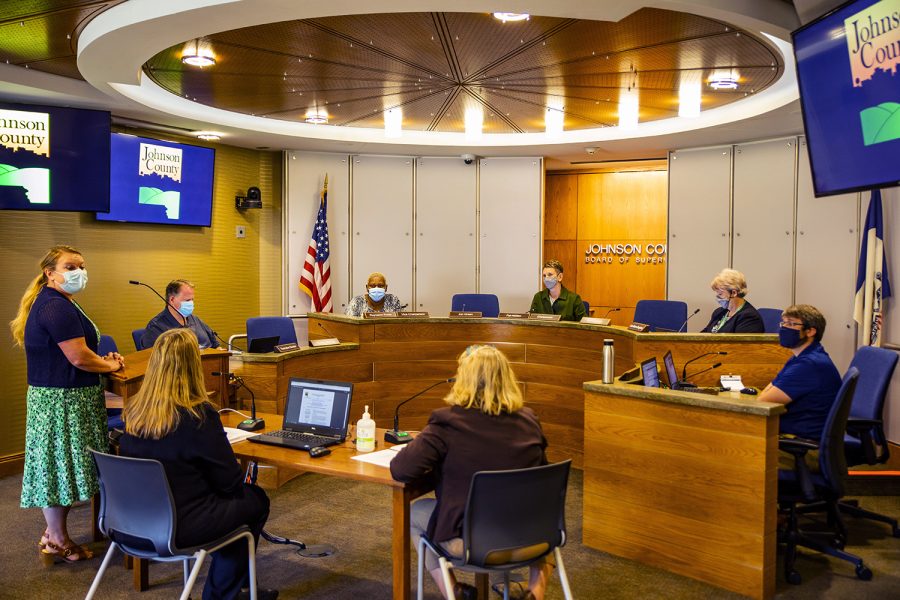Johnson County Board of Supervisors rank projects to distribute federal funds
The Johnson County Board of Supervisors gave an assessment on the American Rescue Plan Act’s proposed funding.
A Johnson County Board of Supervisors informal meeting is held in the Johnson County Administration building on Wednesday, Sept. 29, 2021.
October 6, 2021
Johnson County is planning to spend millions in COVID-19 relief dollars to jump-start short and long-term projects and cover lost revenue, among other things.
The Johnson County Board of Supervisors met with county staff to continue the discussion on where to allocate the $29.3 million the county will receive from the federal American Rescue Plan at Wednesday’s work session.
Johnson County Departments and Offices were asked to complete an internal needs assessment to gauge where the funds are most needed, and how much should be supplied in preparation for dispersing the money, The Daily Iowan previously reported.
Members of the American Rescue Plan Leadership Team, which is composed of county staff, department heads, and elected officials, presented these results to the Board of Supervisors at their regularly scheduled work sessions on Aug. 18, Sept. 1, and Sept. 8.
During their last update on Sept. 8, the Board of Supervisors asked the Leadership Team staff to organize projects which received majority support into recommended funding categories that could be reviewed and discussed during a work session.
Johnson County Grants Coordinator Donna Brooks broke down the four main areas that the funding will be allocated to:
- Near-Term Funding Opportunities, which focus initial funding decisions on near-term opportunities or to expand existing COVID-19 response programs and initiate short-term projects that can be stood up within six months.
- Transformative Initiatives will be proposed by internal and external stakeholders in Johnson County and are intended to be long-term projects for generations to come.
- The money will also go to county operations, program administration, and contingencies after a calculated loss of $2.6 million in revenue.
- The county is allocating money for technical assistance and support for staff that was made available to assist in the management of Local Fiscal Recovery Funds allocations.
Projects included in these four categories range from implementing a grant program for minority-owned businesses, creating an affordable child care program, and payments to households excluded from previous rounds of federal stimulus checks, which totals $12,357,785.50.
Each project was assigned a number that reflects its allowable use. County staff ranked each project that received majority support from supervisors for discussion, labeling either a one or a two, which correlates to the following criteria to gauge preparedness:
Projects labeled with a “one” were categorized as a primary priority and ready to be enacted. Projects labeled with a “two” were described as secondary priorities in need of additional development.
Supervisor Rod Sullivan said during the work session that he wished the board played a role in assigning numbers to the proposed projects, while also introducing the notion of possibly editing these numbers.
“My concern is I really feel like those are things that I’d like to see the board make that decision,” he said. “Ultimately, I think these decisions have to rest with the board.”
Brooks said numbers were provided as a recommendation based on meetings the team head with county department heads and elected officials.
“We recognize we’re not the decision-makers, we’re just the professional staff leading the initiative,” Brooks said. “We worked with public health staff, and the leadership team to develop a process that we felt would help the board make some primary or initial decisions that would grant the flexibility to get some projects going.”
Johnson County Special Projects Manager Ray Forsythe said it has been difficult hearing back from officials during the procedure of assigning numbers.
“The challenge that we had had during this process is we sent out a request to all the department heads and elected officials and got very little response,” Forsythe said.
After a lengthy discussion that addressed the nearly 50 proposed projects listed in the four categories, board members said they are waiting on the input of other department heads and elected officials before authorizing any American Rescue Plan spending.
“We have some things we need to get back to you,” Forsythe told the supervisors. “Better descriptions on the final document, then I think we can take a stab at initial urgent projects.”
Further discussion of American Rescue Plan Act’s funding is slated for next week’s work session.






